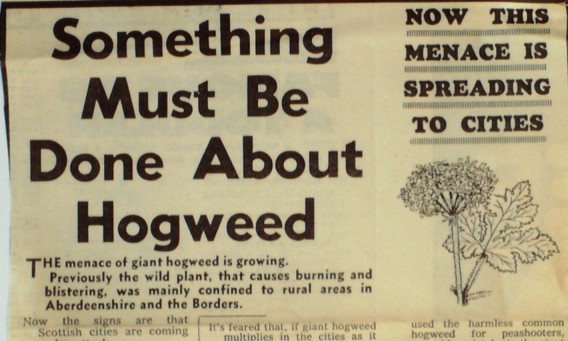
EXPERTS claim swingeing cuts to council gardening budgets are to blame for the spread of a huge toxic plant.
Giant hogweed is rife throughout Britain and its poisonous sap has caused scores of people to suffer serious burns this summer.
It’s now being warned cutbacks in culling the plant are responsible.
The note of alarm comes
30 years after a hard-hitting Sunday Post campaign sparked a country-wide clean up of giant hogweed.
Guy Barter of the Royal Horticultural Society said: “We’ve turned our backs on giant hogweed to focus on other priorities.
“This may also be driven by climate change as more rainfall drives the spread of seeds through rivers and onto embankments.
“The explosion will become massive unless there is aggressive control.
“Efforts were made to control it in the 1980s but it slipped off the agenda and has spread extensively.”
The Triffid-like invader, which was shipped to the UK from Russia in the 19th Century for ornamental gardens, has bred with gentle native hogweed to produce a tough hybrid version of the plant.
Dr Mark Watson, of Edinburgh’s Royal Botanic Gardens, said it has “flourished on neglect”.
He explained: “Giant hogweed can withstand the tough Russian weather so it flourishes in the UK.
“Each head can produce up to 80,000 seeds which are scattered by wind and down rivers.
“We need to focus on culling this out-of-control plant.”
Terence O’Byrne, 59, chairman of Dunblane Community Council, has been destroying hogweed by spraying his local park for three years.
“There is little will to destroy this so I have taken it on myself,” he said.
“I have contacted all MSPs to outlaw the weed because it is dangerous, It should be an offence to have it on your property.
“But destroying hogweed is just not on the agenda.”
Giant hogweed can grow up to 20ft tall and can take up to four years to flower.
It’s estimated the damage caused by the plant costs
British taxpayers a staggering £1.7 billion a year.
Weed control companies say their phones have been “ringing off the hook” with land and homeowners fighting a losing battle to control it.
Pat Burns, of Kleerkut land and property managers in East Kilbride, South Lanarkshire, said: “Clearing giant hogweed has not been top of the public spending priority.
“The nation is paying the price for easing up on control.
“Homeowners who neglected it have had to spend up to four years controlling the hogweed and its seeds.
“They can lie dormant in the ground for up to seven years.
“Mortgage lenders are now casting a suspicious eye over property with giant hogweed in the way they do over Japanese knotweed.”
Chemical suits, masks and rubber boots are needed by weed control teams to protect them against the hogweed’s caustic sap while construction firms have even resorted to using mechanical scrapers to dig out top soil to rid building sites of the weed.
Giant hogweed contains chemicals photosensitising furanocoumarins which react to light when they come into contact with human skin.
This can cause blisters, lesions and sun burn and also blindness if the sap is rubbed into the eye.
Symptoms can take up to 48 hours to appear.

Enjoy the convenience of having The Sunday Post delivered as a digital ePaper straight to your smartphone, tablet or computer.
Subscribe for only £5.49 a month and enjoy all the benefits of the printed paper as a digital replica.
Subscribe